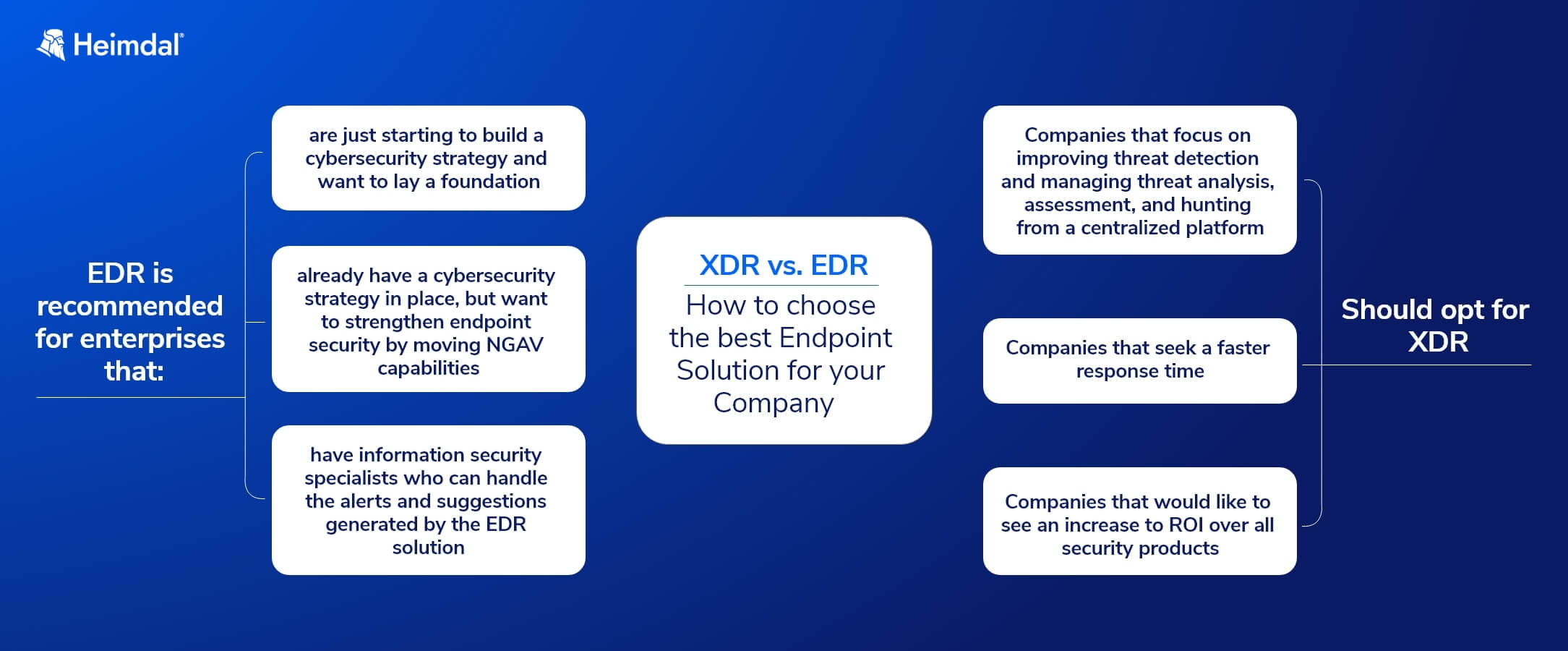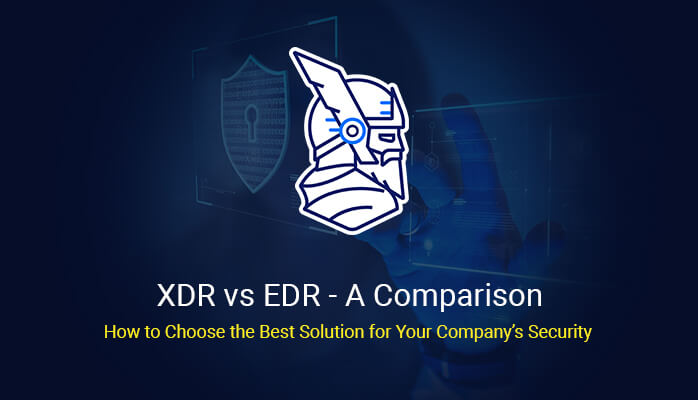Source: heimdalsecurity.com – Author: Andreea Chebac
Cybersecurity purchasers and providers must adopt a new way of thinking in response to the more sophisticated cyberthreats that keep emerging. The necessity for more thorough and integrated approaches to cybersecurity is highlighted by the fact that traditional cybersecurity solutions cannot keep up with complicated attack vectors.
Extended Detection and Response (XDR) is such a revolutionary that is currently increasing by approximately 15-20% per year, which is rather intriguing given that the less sophisticated technique, EDR, is still expanding by 20-25% but approaching growth maturity.
Why will XDR most likely take control? Let’s discuss XDR vs EDR, their key characteristics, and how they relate to the state of cybersecurity.
What Is EDR?
Endpoint Detection and Response (EDR) refers to a set of unified endpoint security solutions that integrate data gathering, data analysis, forensics, and threat hunting with the purpose of detecting and preventing potential security breaches in real time.
Endpoint Detection and Response (EDR) platforms were designed to identify and actively respond to any malware and cyberattacks happening on endpoints, as they can detect any unusual behavior that can be examined afterward.
These tools have been specifically built for endpoints (and not networks), as the name implies. Anton Chuvakin, a former Gartner VP and security expert, introduced the acronym EDR in 2013.
What Is XDR?
The abbreviation stands for Extended Detection and Response, and it refers to multi-layered detection and response platform. This technology captures and analyzes data across multiple environments – endpoints, emails, servers, clouds, and networks – to enable proactive threat detection, accelerated incident response, and improved overall security posture.
Thus, XDR can assist your security team in detecting, investigating, and responding to threats across several layers of protection, transgressing endpoint detection. XDR enables more security, awareness, and response capabilities, but also higher productivity and cost reductions.
As cybersecurity expert Joseph Shenouda mentions,
With EDR, you’ve taken end-point security seriously. Continued with XDR, you’ve now enlarged your vision to network activity as well. The goal ultimately is to respond automatically to identified threats.
XDR vs EDR – Differences and Benefits
Let’s take a closer look at the two solutions, how they are different and what benefits they can bring:
Legacy Security Gaps and the Rise of XDR
Antivirus software and firewalls are examples of traditional security methods, although they aren’t always successful at spotting and stopping contemporary cyberthreats. Since these tools are frequently the “baseline” of an EDR product, their tendency to operate in isolation leads to fragmented visibility and delayed incident response, which is the first factor driving the need for market transformation.
You may recall that as threats become more complex, the need for a more comprehensive strategy arose. In response, XDR was created, which spans the gap between several security verticals and offers a single view of the threat landscape.
According to Gartner, XDR is “a comprehensive, cloud-native, and analytics-driven security offering that combines multiple security products.” Whilst that is true, my view is that to benefit and leverage XDR, you need those tools to be well integrated, which is not really what the Gartner definition says. Also, the definition is quite vague, because typically those tools are mainly reactive, whereas (and incoming advertisement alert), the Heimdal stack is heavily focused on having a proactive, predictive security posture stopping threats before they come in, which no one else really offers.
Morten Kjaersgaard, Heimdal’s CEO
Integration and Consolidation of Security Tools
With XDR, security platforms are becoming more integrated as opposed to conventional point solutions. It combines data from several security spheres and makes use of cutting-edge analytics and machine learning algorithms to find hidden hazards and patterns. A comprehensive and contextualized view of the whole attack lifecycle is provided by XDR by combining and correlating data from many sources. Making this data useful, which is a challenge for most platforms, is another important point that the buyer should keep in mind.
The goal of tool integration is to improve security operations’ effectiveness by reducing false positives and enhancing threat detection and response capabilities. Again, here is where XDR clearly outperforms EDR because the EDR platform is solely focused on the endpoint, whereas data today is dispersed across a much larger surface due to the complexity of security.
A Forrester report predicts that “by 2024, 50% of enterprises will have begun to consolidate their standalone security products, including EDR, NDR, and UEBA, into comprehensive XDR platforms.” This really supports my firm believe that the market will be evolving, but there are many different views on the matter.
One thing I would stress though to IT managers, CIOs and general managers, is to make sure they get the necessary visibility of the risk, and to ensure the necessary actionability of threats.
Morten Kjaersgaard, Heimdal’s CEO
Advanced Analytics and AI-Driven Automation
To evaluate enormous amounts of security data in real time, XDR uses the power of artificial intelligence (AI) and machine learning (ML). AI-driven algorithms can spot patterns, anomalies, and signs of compromise that human analysts would miss. Even if this makes threat hunting, quicker incident response, and accurate detection of developing threats possible, keep in mind that this is still a “post threat” environment, as opposed to the mindset we strive to adopt with Heimdal, which is BEFORE the issue even materializes.
In your role as an IT manager, CIO, or CISO, you should focus more on preventing risk than managing it once it arises. In addition, you should continue to think about actionability and proactive risk mitigation rather than reactive risk mitigation as you decide whether it is time to start thinking about switching from EDR to XDR and the budgetary effects of that.
The integration of AI and ML in XDR platforms is also much stronger than in EDR, which minimizes the workload on your security teams and frees them up to focus on strategic projects. This is another important factor that might work in your favor with XDR being superior to EDR. Threats can be contained and possible damage can be mitigated faster thanks to automated incident response and remediation.
Cloud-Native XDR for Hybrid Environments
Cloud-native security solutions are essential as more businesses use cloud computing and hybrid/multi-cloud systems. As opposed to EDR systems, which by their very nature are endpoint products, cloud-native XDR expands the capabilities of existing XDR platforms to cover cloud workloads, apps, and infrastructure.
Organizations are able to efficiently detect and respond to attacks in dynamic cloud settings thanks to the integration of cloud-native XDR with cloud-native security measures. This might be data storage in the cloud, email processing through O365, or logins to Azure Active Directory.
External MDR / SOC / MXDR
The unified nature of a comprehensive XDR platform offers one more and last benefit, making it simpler for MSPs, CIOs, CISOs, IT managers, and board members to decide whether to internally or externally monitor the platform.
Given that XDR is only a technology and not a guarantee of accurate threat visualization, you must obviously ensure that what you purchase also offers that. At Heimdal, we connect this to Threat-hunting and Action Center, the gold standard of straightforward cybersecurity management. However, once you have a visualization and overview tool in place, you can easily decide whether to monitor and act on the XDR discoveries yourself or to outsource them to your technology or SOC supplier.
How to Choose the Best Endpoint Solution for Your Company
While security is critical for any business, regardless of size, each organization’s requirements are unique. As a result, it is essential to choose a security product that delivers the appropriate type of coverage depending on the risk profile of the organization. Here are a few guidelines to consider while deciding between an XDR solution and an EDR one.
EDR is recommended for enterprises that:
– are just starting to build a cybersecurity strategy and want to lay a foundation.
– already have a cybersecurity strategy in place, but want to strengthen endpoint security by moving beyond NGAV capabilities.
– have information security specialists who can handle the alerts and suggestions generated by the EDR solution.
XDR is better suited for companies that:
– focus on improving threat detection and managing threat analysis, assessment, and hunting from a centralized platform.
– seek a faster response time.
– would like to see an increase in ROI over all security products.

XDR and EDR in the Heimdal® Suite
Heimdal’s Endpoint Detection and Response offers unrivaled prevention, threat-hunting, and remediation capabilities, combining six solutions in a single easy-to-deploy and compact agent that will not delay your systems and will help you save significant time. This is highly appreciated by our customers, as you can see in our NRGi Case Study:
What I like about Heimdal’s EDR product suite is that it
offers all-in-one endpoint protection. By using it, I
eliminated the need for any additional tools to protect
company endpoints. Heimdal is a completely unified
solution that I am very happy with. In terms of how
Heimdal improved our operations, if I take a look at my
own department, namely IT, I can see that our team’s
efficiency was considerably enhanced since we started
using Heimdal.
We can manage our cybersecurity under one seamless
roof in the dashboard, which saves them a lot of time. In
addition to this, our over 1,400 users don’t notice
Heimdal products running in the background, which
minimizes interruptions throughout the workday and
improves their productivity as well.
Michael Warrer, Group CIO, NRGi
We can protect your network from sophisticated cyberthreats and go beyond what conventional security solutions can achieve. Our EDR software can prevent advanced ransomware, insider threats, admin rights abuse, APTs, software exploits, brute force attacks, DNS and DoH Vulnerabilities, phishing and social engineering, and any other known or unknown threats by leveraging the benefits of Machine Learning and AI-driven intelligence.
Our Extended Detection and Response Powered SOC Service functions as a centralized monitoring and incident response hub, notifying you of infections or attacks, monitoring your environment, evaluating policies for optimum compliance, and applying quick and effective countermeasures to attacks.
The Heimdal XDR-powered SOC Teams respond quickly to malicious incidents by blocking domains, quarantining malicious processes and e-mails, deploying critical vulnerability patches, and isolating compromised devices. Our teams report the findings, actions, and resolutions of incidents both while and after they occur. They also provide actionable strategies to avoid future attacks on the vulnerable routes.
Supported by a next-generation SOAR (security orchestration, automation, and response) platform, our SOC teams can proactively reduce attacks by automatically patching critical vulnerabilities and monitoring and adjusting the security settings on a regular basis.
If you need help in choosing the best approach for your company, don’t hesitate to request a demo of our solutions – one of our consultants will contact you shortly after.
The next level of security – powered by the Heimdal Unified Security Platform
Experience the power of the Heimdal cloud-delivered XDR platform and protect your organization from cyber threats.
- End-to-end consolidated cybersecurity;
- Complete visibility across your entire IT infrastructure;
- Faster and more accurate threat detection and response;
- Efficient one-click automated and assisted actioning
Final Thoughts
XDR means taking things one step further and having a much-needed visibility into all you attack surface. This way, when EDR will naturally start to fade out, and XDR will be by far the fastest-growing market and drive consolidation in cybersecurity, you will have a big advantage.
Drop a line below if you have any comments, questions, or suggestions regarding this topic of XDR vs EDR– we are all ears and can’t wait to hear your opinion!
If you liked this article, be sure to follow us on LinkedIn, Twitter, Facebook, and YouTube to stay up to date on everything we publish!
Original Post URL: https://heimdalsecurity.com/blog/xdr-vs-edr/
Category & Tags: Endpoint security,EDR,XDR – Endpoint security,EDR,XDR





















































